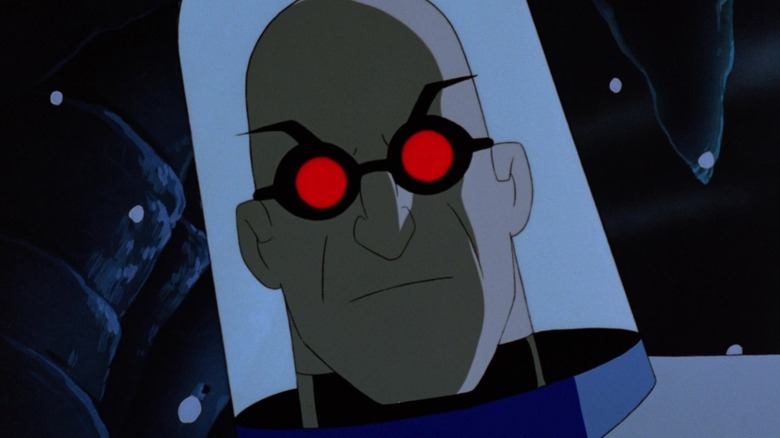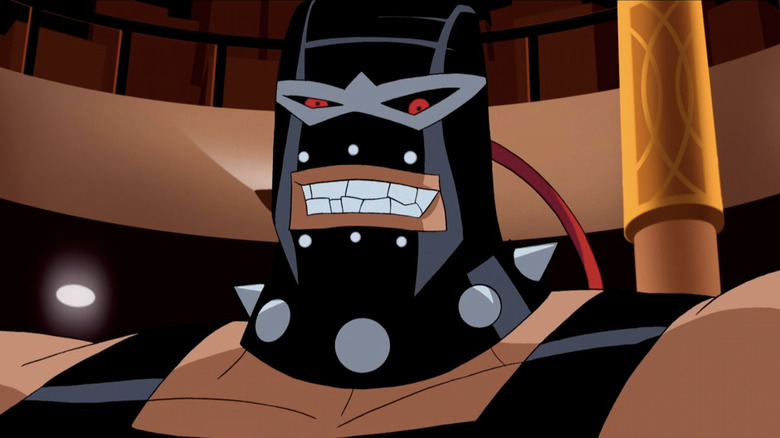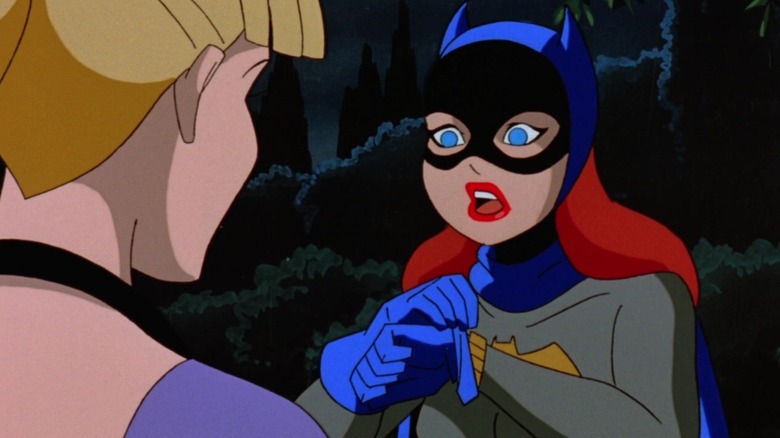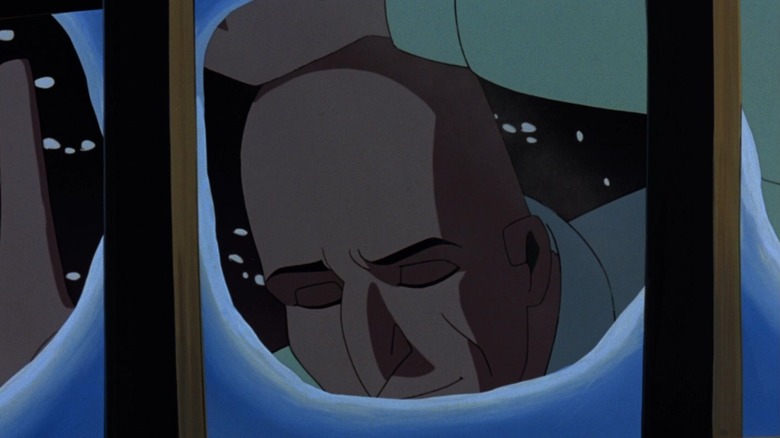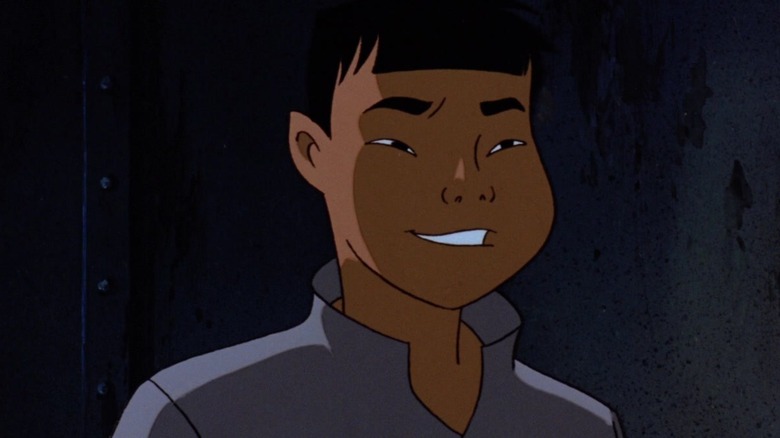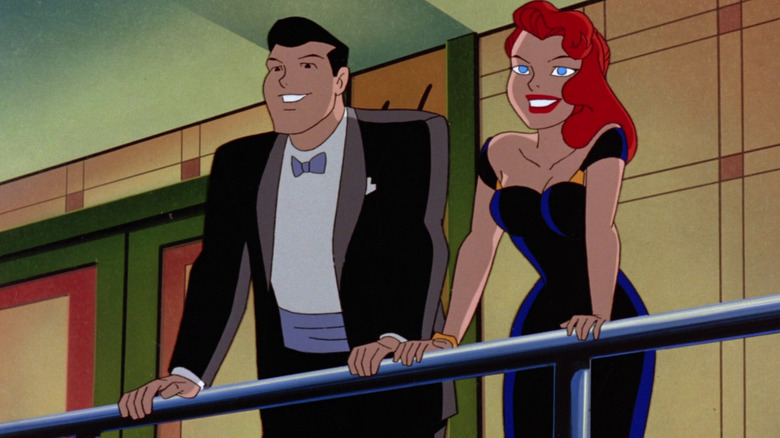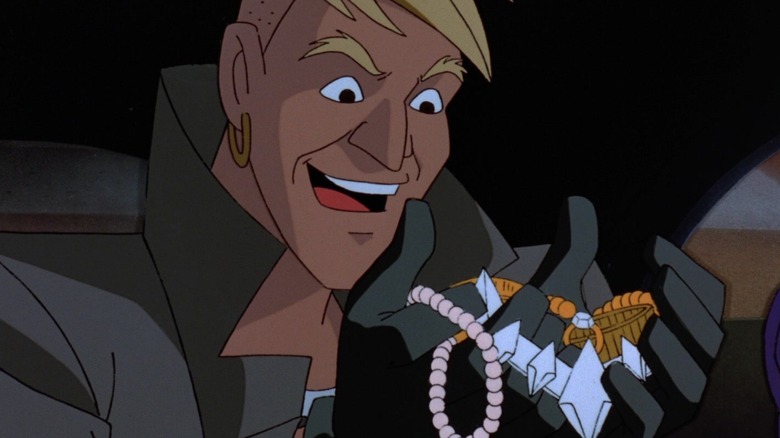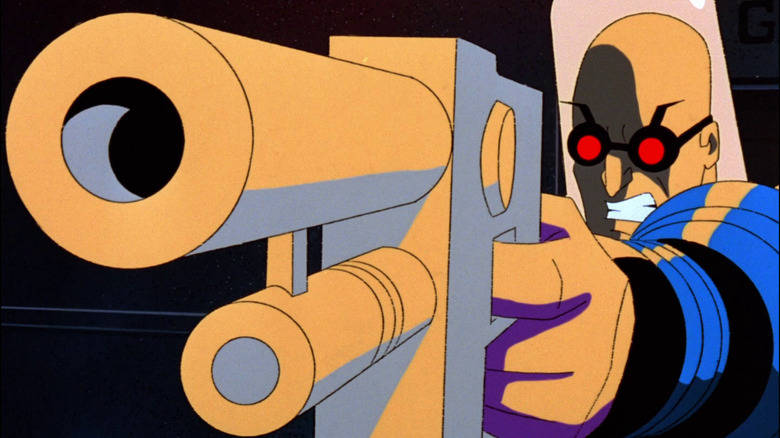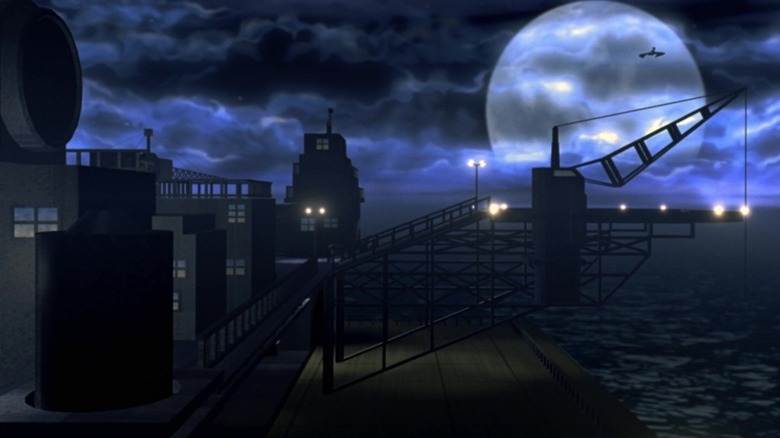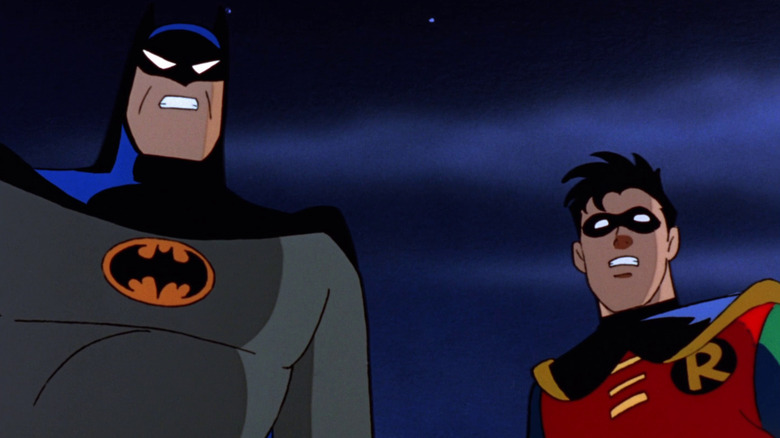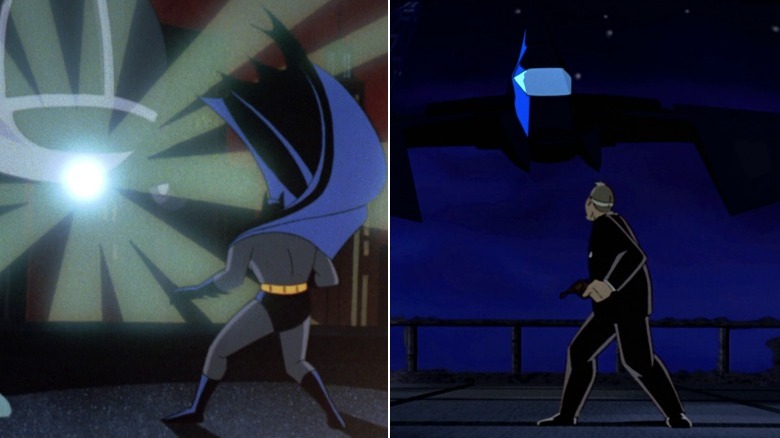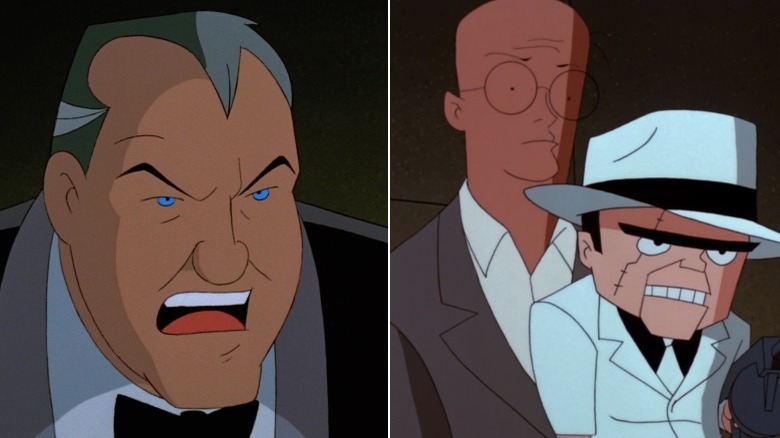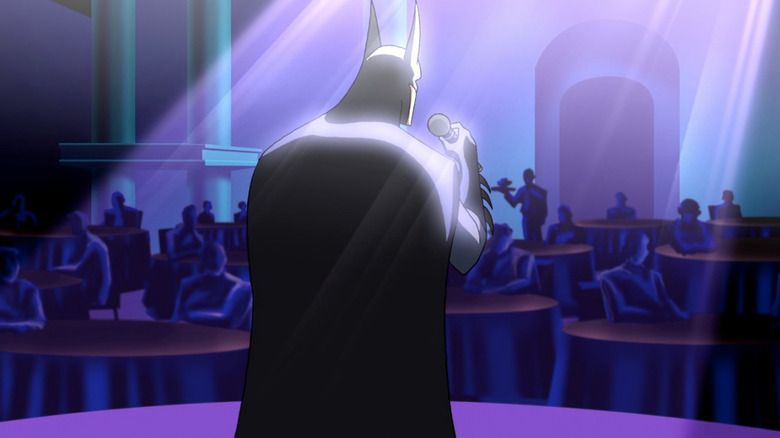Batman & Mr. Freeze: SubZero Details That Will Give You Chills
On March 17, 1998, a chill swept through Gotham City. On that day, "Batman & Mr. Freeze: SubZero" hit video store shelves, pitting Batman (Kevin Conroy), Robin (Loren Lester), and an out-of-costume Batgirl (Mary Kay Bergman) against their coolest foe — pun intended. Hanging in the balance is the life of Mr. Freeze's (Michael Ansara) wife, Nora Fries, who needs an organ only Barbara Gordon aka Batgirl can provide. Freeze aka Victor Fries will stop at nothing to rescue his wife, even if, as Barbara learns when Freeze kidnaps her, the operation is lethal for the donor.
Co-written by longtime "Batman: The Animated Series" contributors Randy Rogel and Boyd Kirkland, "SubZero," unlike the theatrical movie "Batman: Mask of the Phantasm," went straight to home video upon release, but that doesn't mean it should be underestimated, as it's an essential part of "Batman: The Animated Series" and DC Animated Universe lore regardless. Though not as often revisited as "Phantasm," the movie has more to its icy exterior than fans might realize. Did its writers always intend for Freeze to be the film's villain? Was it meant to tie into Joel Schumacher's 1997 movie "Batman & Robin" in some way, and if so, why the wait between films? And which major DCAU figure was not involved in the movie's creation? Mind the thermostat and watch where you park your submarine, as it's time to thaw out the secrets of "Batman & Mr. Freeze: SubZero."
It was originally going to star Bane
One could easily be forgiven for thinking "SubZero" was always meant to be a Mr. Freeze story. After all, the film was released less than a year after "Batman & Robin," which also features Freeze as a major villain — something that was definitely not coincidental, as "SubZero" co-writer Randy Rogel explains in "Back Issue!" #99.
Yet despite the tie-in potential, Mr. Freeze was not going to be the original antagonist of the second "Batman: The Animated Series" film. Instead, it would have been another villain from "Batman & Robin" — Bane. Rather than be a growling henchman to Poison Ivy and Mr. Freeze, however, Bane would have been the lead foe, portrayed much closer to his comic book roots. Or as Rogel put it to the Watchtower Database YouTube channel, "Why don't we make Bane basically the Terminator and you can't kill this guy?"
Ironically, it was the casting of the real Terminator, Arnold Schwarzenegger, as the cold-themed criminal in "Batman & Robin" that put the Bane story on the back-burner, as Warner Home Video consequently asked that the film instead be Freeze-centric. Eventually, Bane would indeed make it into a DCAU feature film: "Mystery of the Batwoman," acting as a villainous lead alongside the Penguin and Rupert Thorne.
It was pushed back almost a year
Given the influence "Batman & Robin" had on determining who'd vex Gotham's Caped Crusaders in "SubZero," it may be surprising to learn that there's a nine-month gap between the live-action feature's June 20, 1997, release date and "SubZero's" March 17, 1998, debut. As "Back Issue!" No. 99 explains, "SubZero" and "Batman & Robin" were actually going to coincide at one point. Yet when the Joel Schumacher movie looked like it might be in for a rough reception, Warner Bros. held off on "SubZero" so that it wouldn't affect any "Batman & Robin" box office winnings.
Given how "Batman & Robin" did indeed do worse critically and financially than the studio had hoped, delaying "SubZero" may have been the right call. Distancing the animated movie from the live-action one might have even helped the "SubZero" sales — it pulled respectable numbers even two months after its release, remaining among the top 10 most-sold children's videocassettes across the U.S. throughout May, according to Billboard (via UPI).
Bruce Timm had no involvement in the movie
Undoubtedly, the biggest name associated with anything DCAU-related is Bruce Timm. And rightfully so — the creator has overseen every single major DCAU television series, with the exception of "Static Shock" and "The Zeta Project".
Yet that hasn't quite been the case with the movies. Though he has been involved with many of the ones set in DCAU continuity, including "Mask of the Phantasm" and "Return of the Joker," a few have been made without his guidance, including "SubZero." While Timm does consider the movie canon to the DCAU regardless, he disagrees with the film crew's decision to portray Nora as being alive. "As far as I was concerned, Nora Fries was already dead in 'Heart of Ice' — 100% dead, dead as a doornail — her lifeless corpse preserved in the cryo-chamber, not still-clinging-to-life in suspended animation," he asserted in "Back Issue!" #99. It is true, however, that Nora's status is somewhat nebulous when she first appears on-screen in the "BTAS" episode "Deep Freeze," as the dialogue doesn't quite clarify whether her in-stasis body is dead or comatose.
It nearly ended Mr. Freeze's story in the DCAU
Mr. Freeze is a character with a very clear arc in "Batman: The Animated Series." When he's first introduced, it's strongly suggested that he believes Nora to be dead, lost in the explosion that also changed Victor into Mr. Freeze. Yet the episode "Deep Freeze" reunites Victor with his wife's preserved body thanks to wealthy amusement park creator Grant Walker (Daniel O'Herlihy). "SubZero" not only reveals that Nora does indeed live within her stasis tube, but also cures her. Since Freeze's entire villainous career stems from his grief for his wife, the movie feels like a finale for the character's days as a criminal.
This, naturally, meant that reverting him to his villainous ways for "The New Batman Adventures" required somewhat of a rethink. As Bruce Timm and Dan Riba explain in the featurette "Arkham Asylum: Examine the Top-Secret Case Files of the Dark Knight's Many Foes," they settled on the idea that even with Nora cured, Freeze still felt unable to be with her, given his physical condition and criminal history. On top of that, "The New Batman Adventures" also reveals that Freeze's transformation takes an adverse toll on him after "SubZero," reducing him to a head, further complicating a romantic reunion with Nora. Add to that the fact that Nora remarries when Freeze doesn't return to her, and a new motivation for Victor is born — to make every Gothamite share his sense of loss.
Koonak's one other appearance
The first few minutes of "SubZero" show that a bit has changed for Mr. Freeze since he was last seen in the "Batman: The Animated Series" episode "Deep Freeze." For one, he's somehow managed to free himself and Nora from the gigantic ice block the two become trapped in during that episode's final moments. The bigger shock, however, is that Freeze has also become guardian to a 12-year-old named Koonak (Rahi Azizi). Though he befriends Barbara Gordon, Koonak remains loyal to Freeze until he sees Barbara fiercely resisting Freeze and Dr. Gregory Belson's (George Dzundza) attempts to sedate her. Realizing the medical procedure Freeze needs Barbara for in order to save Nora's life isn't as benevolent or harmless as Freeze suggests, Koonak turns on him, allowing Barbara to escape. The favor's returned shortly after when Barbara saves Koonak before Freeze's oil derrick becomes completely covered in flames.
Since "SubZero," Koonak has never appeared in an animated movie or TV show set in the DC Animated Universe, leaving his fate a mystery. Fortunately, issue 15 of the DCAU-inspired "Batman Adventures" comic provides a potential answer. In the issue's second story, Nora tracks Koonak down, and the two exchange their impressions of the man at Koonak's orphanage before Nora goes off to find Victor. Aside from showing just how Koonak and Freeze met, it also portrays the young boy as having conflicted feelings about the cryogenic criminal, ultimately still caring about him, but also wary of Freeze's growing villainy.
The movie won an Annie
"SubZero" is arguably somewhat overlooked as far as DCAU films go, overshadowed in some ways by "Batman: Mask of the Phantasm" and "Batman Beyond: Return of the Joker." It is hard, after all, to compete with what is essentially the DCAU Batman's origin story and Terry McGinnis' (Will Friedle) showdown with the biggest Batman foe.
That isn't to say "SubZero" hasn't gotten its recognition, however. In what was a pretty stunning year for DCAU-related content, "SubZero" was prized at the 26th Annie Awards in 1998 with the Annie Award for Best Home Video Animation, beating a number of sequels to popular films like "Fern Gully" and Oscar-winner "Beauty and the Beast," along with a "Winnie the Pooh" film. It found itself in some pretty familiar company, as "The New Batman/Superman Adventures," the block in which "SubZero" sequel series "The New Batman Adventures" would air, won an Annie for Outstanding Achievement In An Animated Daytime Television Program the same year.
A scene comes from the script that got Randy Rogel hired on Batman
While Bruce Timm, Paul Dini, and Alan Burnett are among the most cited creative forces behind the stories for "Batman: The Animated Series," in reality there were many talented people responsible for the show's success and acclaim. One was "SubZero" co-writer Randy Rogel, whose writing credits include Two-Face's game-changing debut and "Riddler's Reform." Rogel, as he tells the Watchtower Database (via YouTube), joined the show as a writer after impressing showrunner Alan Burnett with two spec scripts he'd written, including one called "The Ape Man."
Though Rogel worked on numerous episodes that made it on air, "The Ape Man" itself never went into production. As Watchtower Database co-founder James Strecker explained to Looper, however, Rogel was able to import a scene involving a jewelry store break-in virtually verbatim into "SubZero," where the jewel thieves are stopped by the Dynamic Duo.
It's the first time in the DCAU Mr. Freeze kills on-screen
"Heart of Ice" is a revelatory "Batman: The Animated Series" episode that tells viewers a lot about Mr. Freeze as a person. While the most remembered detail is likely Freeze's love for his wife, Nora, "Heart of Ice" also illustrates a more coldblooded side to the character, and not just in the literal sense. As Freeze himself admits in the episode, he's a man who has no problem taking lives to get what he wants. Yet despite his efforts, Freeze never actually succeeds in killing anyone on the show. This could very well have been to avoid the ire of Broadcast Standards and Practices, which as Bruce Timm notes in "Modern Masters Volume Three: Bruce Timm," could sometimes be tough on "BTAS."
By comparison, however, "SubZero" doesn't seem bound by as many restrictions. While co-writer and director Boyd Kirkland told Comics Continuum that "SubZero" was written to be deliberately more restrained in the violence department, Freeze seems to cross a line not seen on-screen before when he freezes an entire submarine crew for unwittingly placing Nora's life in jeopardy. It's never stated whether Freeze kept the crew in that condition, but given Victor's merciless side and the fact that none of the frozen submarine characters reappear later, it's very possible Freeze kept them encased in ice for good. "SubZero" also pushes the violence envelope with Freeze ally Gregory Belson, as the character's final scene ends with an aircraft landing pad falling on him.
It's a CGI milestone for the DCAU
"Batman: The Animated Series" was a primarily hand-drawn show, but that didn't mean it wasn't open to trying its hand at some computer-generated effects now and again. Some CGI, for example, is used in "Batman: Mask of the Phantasm," notably to make the Gotham City buildings that appear at the start of the film, as GeekTyrant points out. It also fittingly appears to have been used in the time-bending episode "Time Out of Joint."
"SubZero," however, took the show's CGI usage to a whole other level. The exterior shots of Wayne Manor and the Batwing, for instance, are purely computer-generated, as are parts of the Batcave and the oil derrick Mr. Freeze eventually adopts as his latest hideout. Computer animation is also used to have certain characters move around, such as in a three-way chase scene and when Freeze's polar bears are swimming in Arctic waters. CGI usage would eventually make its way into later DCAU shows such as "Justice League" and "Justice League Unlimited."
It ended an era
While Bruce Timm's most iconic version of Batman would go on to appear in many more series, "SubZero" essentially closes out the "Batman: The Animated Series" era. It's the last feature drawn in the show's signature 2D animation style, as it was replaced by a more simplified, angular look for its chronological follow-up, "The New Batman Adventures."
Kevin Conroy's original voices for Bruce Wayne and Batman are also effectively "retired" here, as Conroy would make the two performances more similar and less emotive to suit the changes the character undergoes in "The New Batman Adventures" era. It's also the final — and only — time Loren Lester voices Dick Grayson in a film while the character is still Robin, as Grayson is well into his Nightwing career when Lester reprises him in "Batman and Harley Quinn."
The callbacks
Understandably for a movie derived from a popular animated series, "SubZero" has some fun callbacks to a few pretty prominent — and even award-winning — "Batman: The Animated Series" episodes. Notably, there's the return of GothCorp, Mr. Freeze's former place of work from his inaugural story, "Heart of Ice," whose management seems to have notably improved since its last appearance. Similarly, Dick Grayson's gravity-defying motorcycle jump while he's chasing Freeze is very reminiscent of a similar motorcycle stunt he pulls as Robin in "Robin's Reckoning: Part II."
There's also a pretty overt visual tip of the hat to the previous "Batman: The Animated Series" movie, "Mask of the Phantasm." Pause on the scene where Gregory Belson turns to see the Batwing hovering before him and you'll find that it's staged exactly like the "Phantasm" moment when a police helicopter confronts Batman. Intentional or not, it's a nice visual parallel between the films, not to mention somewhat of a "reward" for Batman, as in "SubZero," he's the one pursuing a real wrongdoer, whereas in "Phantasm," he's being chased for crimes he didn't commit.
I know that voice
The DCAU has always been known for recruiting stunning voice talent, including some pretty well-known celebrities. "SubZero," for instance, brings back "Taxi" star Marilu Henner as Veronica Vreeland, a role Henner played the entirety of "Batman: The Animated Series." Similarly, noted voice actor Mary Kay Bergman plays Batgirl in the place of Melissa Gilbert, and Michael Ansara, known well among "Star Trek" fans for portraying Kang, reprises his role of Mr. Freeze.
What may surprise some fans is that a very familiar DCAU presence voices Freeze's fellow cryogenics researcher turned partner-in-crime Gregory Belson. While "SubZero" is Belson's first — and seemingly last — appearance, his actor, George Dzundza, is a pillar of Bruce Timm's signature animated universe. Dzundza famously plays the Ventriloquist and Scarface in "Batman: The Animated Series" and "The New Batman Adventures," as well as Superman's famous boss, Perry "Don't Call Me Chief" White, in "Superman: The Animated Series." It seems fairly fitting for a man who plays a criminal puppeteer to voice so many characters. Dzundza, of course, has also attained on-screen fame as Max Greevey on "Law & Order," among many other roles.
The song that would become a Batman and Kevin Conroy favorite
"Justice League Unlimited," one of the many sequels to "Batman: The Animated Series," has plenty of standout moments for the Dark Knight. One of the most beloved is his surprise rendition of the song "Am I Blue?" by Harry Akst and Grant Clarke in the episode "This Little Piggy." The song has not just become synonymous with the DCAU Batman, but also his actor, Kevin Conroy, who revisited the song many times since, including on his website and on social media (via Twitter).
While "Am I Blue?" will be forever associated with that moment, not everyone will know or remember that the song debuted even earlier in the DCAU in, you guessed it, "SubZero." Keep your Bat-ears alert and you'll hear a fast-paced rendition of the tune during Gregory Belson's phone conversation with Jenny, Barbara's roommate. It's not the only famous song in the movie, either, as the Flamingos classic "I Only Have Eyes For You" can be heard during a romantic moment between Barbara Gordon and Dick Grayson.
